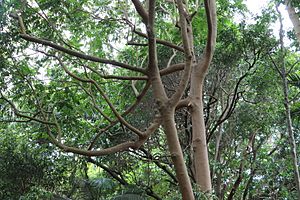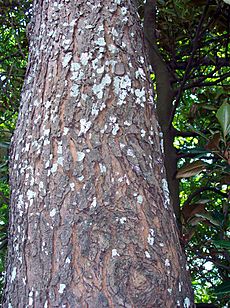Miva mahogany facts for kids
Quick facts for kids Miva mahogany |
|
|---|---|
 |
|
| Miva Mahogany at the Royal Botanic Gardens Sydney | |
| Scientific classification |
|
| Kingdom: | Plantae |
| Clade: | Tracheophytes |
| Clade: | Angiosperms |
| Clade: | Eudicots |
| Clade: | Rosids |
| Order: | Sapindales |
| Family: | Meliaceae |
| Genus: | Dysoxylum |
| Species: |
D. mollissimum
|
| Subspecies: |
D. m. subsp. molle
|
| Trinomial name | |
| Dysoxylum mollissimum subsp. molle (Miq.) Mabb.
|
|
| Synonyms | |
|
|
The Dysoxylum mollissimum subsp. molle, often called the red bean or Miva mahogany, is a tall tree found in rainforests. It belongs to the Meliaceae family, which includes many types of mahogany trees. You can find this tree in tropical and sub-tropical rainforests in eastern Australia. It grows from the Bellinger River in New South Wales up to the wet tropics of north-eastern Queensland. It also grows in Malesia and some islands in the south-western Pacific. The name mollissimum comes from Latin and means "very soft." This describes the soft, hairy feel of its leaflets. You can see a signposted red bean tree near the car park at Victoria Park Nature Reserve in New South Wales.
Contents
About the Miva Mahogany Tree
This is a very large and impressive tree. It can grow up to 35 meters (about 115 feet) tall. Its trunk can be as wide as 120 centimeters (about 4 feet) across. The base of the trunk often has strong, wide supports called buttresses. The trunk's bark is rough and scaly. It is usually grey or brown. If you cut the bark, it might smell a bit like an onion.
Leaves of the Red Bean Tree
The leaflets of the Miva mahogany usually grow opposite each other on the stem. They do not have jagged edges. The base of each leaflet is often a bit uneven. These leaflets are usually 6 to 15 centimeters (about 2.4 to 6 inches) long. They are also 2 to 5 centimeters (about 0.8 to 2 inches) wide. The top side is a medium green, and the underside is paler. Sometimes, the underside can feel softly hairy.
The true leaves of the tree are much longer, about 30 to 60 centimeters (about 1 to 2 feet) long. They are pinnate, meaning they have many leaflets arranged along a central stem. The part of the leaf stem where it joins a larger branch is often swollen. You can easily see the veins on both the top and bottom of the leaves. They are raised and stand out more on the underside. The veins are a creamy green color, which makes a nice contrast with the darker leaf.
Flowers and Fruit (Reproduction)
The Miva mahogany produces white flowers. These flowers grow in clusters called panicles. You can see them blooming from January to July. After the flowers, the tree grows fruit. The fruit is a brownish capsule, which is like a small, dry pod. It is about 2 centimeters (about 0.8 inches) across.
Inside the capsule, there are usually one to five small sections. Each section holds one reddish-brown seed. The fruit ripens between November and March. Birds enjoy eating these fruits. For new trees to grow, it is best to use fresh seeds.
Timber from the Miva Mahogany
This tree produces a type of wood that is highly valued. It is a kind of mahogany timber. The wood is reddish-brown and easy to work with. This makes it great for making furniture, carving, and building boats. The lighter wood on the outside of the trunk, called sapwood, is a creamy pink color. However, this wood is not resistant to termites. It is important to be careful when working with the wood, as inhaling the wood dust can be a concern.


